summer08
INSIDE THIS ISSUE:
by Joe Nelson
 |
Photo by Eric Foster April 22, 2008 |
April 22, 2008 The water is still too high to do any work on
the new abutments, said Eric Foster, Vtrans Resident Engineer,
"so we are working on siding and spraying the bridge with fire
proofing and insecticides. The contractor is hopeful to begin
abutment work the week of the 28th. We still have considerable
work on the abutments and approaches. They still want to be
done in June, we'll see if Mother Nature agrees."
The renovation of the Swamp Road Bridge (Salisbury
Station Bridge) is proceeding as usual. With the primary
requirement of Vtrans in mind—highway safety, and the
primary requirement for preservation by the National Register
of Historic Sites, the engineers on the job are challenged daily
to fulfill both. Eric Foster, of Vtrans, and Jim Ligon, of Alpine
Construction, Stillwater, N.Y. are up to the task.
It is expected that 100-plus year old wooden bridges hold
secrets that even the most thorough pre-construction
engineering inspection can't uncover. The "Swamp" bridge
hasn't disappointed. While disassembling the structure to
replace known rot damaged truss members, members thought
to be sound were found to be rotted also. At least one-third
more than the thirty-odd lattice members specified in the
contract were found to need replacement. Surprises were also
found in both upper and lower chords.
March weather and snow melt, caused Otter creek to cover
Cornwall's part of Swamp Road while hurling ice chunks, trees
and other flotsam at the bridge under construction.
(A Look Back) by Mrs. Orrin Lincoln
BACK IN 1872, Harrison "Tip" Chamberlain, Townshend's
famous bridge builder put up what we know as Depot bridge.
High water never effected the bridge as it was over a setback of
the West River. It was then over a narrow dirt road which led
to the former Townshend railroad station. Later this road went
off Route 30. This bridge was of sturdy construction,
Queenpost truss and was built to replace a poorly built
uncovered bridge.
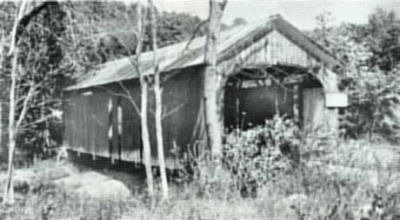 |
CRVCBS Bulletin, Summer 1967 |
Since no place was found to have the bridge placed elsewhere, it was taken down, boards marked and stored at Mr. Aubrey Stratton's place in West Townshend. Mr. Stratton, selectman of Townshend, had been of much help in trying to find a place for this old span.
Several things came up and we believed at one time the old span would be put up in Weston, Vt., and at another we thought it might go to Weathersfield, Conn. But at Mr. Stratton's it remained and as you know, not improving.
Finally we heard rumors that maybe our old span would again be erected. It seemed Mr. V rest Orton, owner of famous Country Store in Weston, was to build a Victorian Village on land he had purchased in sight of Route 103 in Rockingham, Vermont.
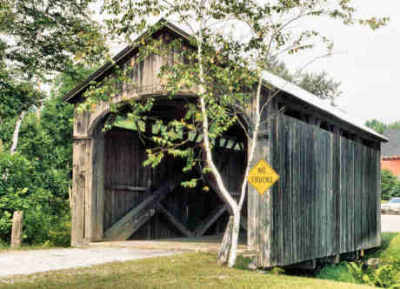 |
Photo by Joe Nelson, Summer 1997 |
As some of you know, Mr. Orton's Country Store is a very attractive reality and nearby over a pond that Mr. Orton had made, the Depot bridge has come to life again, this time only about half as long and now a kingpost truss but with a very sturdy. appearance and as you look at portals you feel you are indeed looking at Depot bridge. AMr. Aubrey Stratton made the pond and put up the bridge.
In visiting the Country Store and talking with Mr. Orton we learn there is to be a mill nearby and one can get beautiful pictures of the bridge or of the bridge and store. So once again it is used for limited traffic, no trucks allowed.
*[From the Connecticut River Valley Covered Bridge Society Bulletin, Summer 1967]
[This article is about fighting graffiti and how communities have come together to eradicate it. As bridgers we know how our covered bridges have been disfigured with it. The article has some ideas worth pursuing and two web-sites that have promising products (marked *). If a reader has had experience with these products in protecting covered bridges, please contact the Bridger. Our thanks to Vermont Local Roads Program at St Michael's College for their permission to reprint this article.]
Graffiti can be a problem on signs especially in large cities. It
may come as a relief that there is “a community Anti-Graffiti
Team in Burlington that includes police officers, business
owners and other community members [who] came together in
January [2007] to create an anti-graffiti plan that proposes
artistic alternatives to random tagging, provides education for
taggers on the aesthetic effects of their vandalism, and impose
a stiffer penalty for anyone convicted of tagging.”
 |
Communities are tackling graffiti vandalism with a variety of tools. A comprehensive, systematic approach that includes continuous education, community involvement, improved technologies for removal, updated ordinances, and consistent enforcement and prosecution is recommended. For an excellent list of best practices visit the Graffiti Hurts web site at www.graffitihurts.org.
Anti-Graffiti sprays exist to prevent graffiti from permanently ruining a sign. New Dimensions Solutions puts out a product known as The Graffiti Shield System. It boasts that the Graffiti Shield System “may be [sprayed] on objects such as public phones, furniture and signs. They do not yellow, peel, flake, chip, nor crack. They enhance the look of all materials and paints. They help prevent rust and corrosion. It resists damage from salt water and is therefore useful on boats and ships. ... The Graffiti Shield System is commonly used to protect murals from graffiti vandalism ... and has been successfully used since 1989.”
Barco Products provides a soy-based non-hazardous and bio-degradable cleaning solution. For a sample, look for SoySafe Graffiti Remover on Barco Products website.
The Town of New Haven coats its signs with a product called Night Owl purchased through State Chemical. The main purpose of this product is to increase reflectivity, but an added benefit is the protection it gives from damage including graffiti. Scott Busier states that “this spray adhesive peels off and can be re-applied if damaged.” A can of Night Owl covers twelve 12x18 signs. Busier states the one downfall is, “the adhesive will only work if the sign is 70-90 degrees at the time of application. This forces us to swap out the signs and take them to the shop to warm up before re-applying.” State Chemical will be discontinuing this product in the near future, so stock up now if interested.
VTrans purchases a product called Graffiti Wipes from Total Solutions (1-414-354-6417). VTrans Traffic Shop states that they’ve been pretty happy with the product so far. It’s nontoxic, non-flammable and non-hazardous. It can also be purchased through Interstate Products. Call Vermont Local Roads if you’d like a copy of the Graffiti Wipes MSDS. Interstate Products also carries Graffiti Guard, a product that acts as a protective barrier making graffiti removal easier.
For more information visit the websites of the above mentioned sources.
http://burlingtongrt.blogspot.com/
www.barcoproducts.com
http://ndclean.com/graffitishield.htm
http://www.interstateproducts.com/graffiti.htm *
http://www.statechemical.com/ *
http://www.graffitihurts.org
http://www.kab.org
 |
Question #7 - Why Preserve our Covered Bridges?
Joseph Conwill, ME - This is a good question, and the
answer is not so obvious as it seems. Covered bridge
preservation is part of the preservation of older architecture
and landscapes in general, but why not just tear down
everything old and build anew?
The reason is that continuity in landscape is a factor in
developing a sense of identity. Without a large number of
familiar and beautiful landmarks, I think people are more
likely to develop rootless alienation. This can lead to
destructive behavior, or to identification with artificial
groupings such as urban gangs or extremist cults.
Covered Bridges should also be preserved simply
because so many people like them, but here we need to be
careful. Construction of new covered bridges is not a valid
substitute for preserving the old ones which have a true depth
of history.
Ben and June Evans, PA - "Why Preserve Our Covered
Bridges?" Because they are historic treasures that display the
architectural genius and excellent craftsmanship of our forefathers
as well as helping to illustrate one of the facets of our
transportation system
Their beauty and charm attract tourists – artists and
photographers especially – and help contribute to the
economic welfare of the area in which they are found. In
some parts of our nation, tourism is listed as the second most
important economic factor.
Sean T. James, P.E., SECB, NH - My answer to the
question is two-fold; the first is to preserve an important part
of our history and the second is that in many locations the
bridges can continue to serve as a vital part of our
infrastructure.
I believe the audience to this question does not need to
be reminded of the importance of covered bridges in our
past. I also believe that they can be an important part of
future as well. Bypassing covered bridges and preserving
them for pedestrian use, such as being done with the
Haverhill-Bath Covered Bridge preserves the bridge for
future generations and allows a more extensive, and safer,
viewing experience
Covered bridges can also be modified with reversible
measures that work in tandem with the original fabric to serve
heavier, modern vehicles loads. This is the case for the
Union Village Covered Bridge in Thetford, VT where the
bridge was preserved and assisted with heavier loads through
the use of glulam beams under the bridge. The beams share
the load with the original bridge and don’t take the full load
as is the case with steel beams. To me this is a great
compromise as the original bridge is left intact, yet it can
carry heavier loads that are critical to the Towns life safety
requirements due to the 14 mile detour to a ‘modern’ bridge.
Bob & Trish Kane, NY - If you look up the word preserve
or preservation using a Thesaurus, you come up with some
interesting synonyms: protect, conserve, safeguard, save,
care for, keep, continue, and sustain. Each of them defines
reasons why we should preserve our covered bridges.
For those of us dedicated to their preservation, it is
obvious we preserve them for their historical significance,
their beauty and their connection to our forefathers. But most
importantly, it is important to preserve them to learn from the
engineering techniques and the craftsmanship from the past.
They are unlike any we see today and they should be
preserved at all costs. Once these wonderful examples are
gone, they are gone forever.
John Weaver, VT - Indeed, why save CBs? Not only for
their historic significance, but for their useful function as
local transportation structures. Many still serve this vital
second purpose on town roads in Vermont.
Rehabilitating covered bridges costs no more (and often
less) than the construction of new bridges at the same or
adjacent sites.
The tourist attraction value and historic preservation
value of rehabilitated covered bridges is an added benefit.
Miriam Wood, OH - The covered timber truss bridge as we
know it today originated in Europe in the Middle Ages and
maybe even earlier, and were very common there. When our
European ancestors came over here in the 1700 and 1800s,
they brought with them the knowledge and skills to build
these bridges. With all the timber available here, thousands
of covered bridges were built across the United State and
Canada.
Hundreds of our old covered bridges still stand, many of
them doing what they were built to do: carrying daily traffic.
The covered bridge is an important part of our engineering
and historic heritage and we must preserve them so future
generations will learn about this important part of our
country’s transportation history.
Thomas E. Walczak, PA - Since the beginning of time, man
has employed his God-given talents and ingenuity to develop
practical solutions to problems to make his quality of life
better for himself and future generations, to erect monuments
to immortalize individuals who have greatly contributed to
their society or accomplished great feats, or to leave lasting
artifacts or works of art which portray the beauty of life as
they knew or perceived it to be or to entertain our senses.
Many of the great cultures or civilizations have left buildings,
monuments, and various artifacts which have endured to the
present time and have stood the test of time and are regarded
to be of value for future generations to learn from and to
enjoy. The ancient Egyptians have left the great pyramids, the
Greeks and Romans have left us their monuments and various
examples of architecture, the Renaissance painters have left
great works of art, various composers have left us with
classical music, while countless inventors and scientists have
left us with their own individual contributions which have
improved the quality of life for many, etc, etc.
Covered bridges too, were a practical solution to fulfill a
basic transportation need and have endured the test of time
and are indeed most worthy of preservation. These 19th and
20th Century landmarks are a testament to the pioneer bridge
builders that speak of the values, character, and work ethic
that made up these men and who contributed greatly to aid
the flow of commerce and to spread expansion and
development of a growing American nation. And too, there
is something to be said about the beauty of a covered bridge
which is comprised of natural materials and looks in harmony
with its natural surroundings. Each covered bridge is unique
with individual characteristics and setting and so we must
make every effort to preserve each one as is humanly
possible.
And so, I believe we have a moral obligation to preserve
these historic icons from our past that have been entrusted to
our care. We are just one generation in a long succession of
those who preceded us and those who will follow us so it is
imperative that we try to preserve these remaining examples
for future generations to learn from and to enjoy. If we fail to
fulfill this obligation then our covered bridges will disappear
forever and future generations will never know the value and
beauty of these magnificent landmarks. The time is now and
we must continue the legacy that has been entrusted to us. It
is my hope that future generations will also continue to
recognize these values and carry on the tradition of
preserving our beloved historic covered bridges after we are
gone.
 VCBS Life Member Ellen Everitz has come up with an idea
to raise funds to support covered bridge preservation. Why
not, she asks, create a Vermont covered bridge video
featuring as many of the bridges as possible. It would be
narrated, with each bridge's history and highlights.
March 22, 2008 - Asked for comment on the East Shoreham
Railroad covered Bridge rehabilitation project, John Weaver,
Vtrans Project Manager replied: "The project field work was
completed by mid January 2008. The top chord and roof are
new and approximately half of the bottom chords have been
replaced. Otherwise - diagonals, floor framing, siding and
bracing are minimally repaired/replaced or original components.
There are a few brand new triangular metal bearing plates. As
you probably remember, this heavy bridge required extensive
shoring during rehabilitation – looks a lot better now. The
standing seam metal roof should last many years." — Joe Nelson
Highlands, NC, May 25, 2008 - The old Bagley covered bridge
serving Warner, New Hampshire, was taken down in the 1960s
and stored. Built in the 1830s to cross the Warner River, it now
spans a creek in downtown Highlands, North Carolina to serve
as an entry to The Bascom Center for the Visual Arts. April 7, 2008, Middlebury, Vt. - Below is a Draft Copy of the applicable portion of the minutes of the Selectboard meeting relative to Pulp Mill Bridge:. Members present: John Tenny, Dean George, Bill Perkins,
Craig Bingham. Victor Nuovo, and Don Keeler. Town Manager Bill Finger asked what the Town could expect in terms of life expectancy of the bridge upon completion. Mr. James explained that it would depend on maintenance, but that a newly renovated bridge should last between 30-50 years. Dean George stressed the point that taking the Pulp Mill Bridge out of service for a year, in addition to the underpass construction in the downtown area, before the Cross Street Bridge is constructed, would create a major impact on the community. Dean asked about the possibility of a temporary bridge at the Pulp Mill Bridge location. Mr. James estimated the cost to build a temporary one-lane bridge to be a million dollars; however, he was not convinced a temporary bridge could be built given the proximity of the houses on either side of the Pulp Mill Bridge. John Weaver of the Vermont Agency of Transportation also noted that permitting would likely delay construction for two years, and the State would have to re-apply for additional funds from the federal government, making the 2011 construction date more realistic.
Mr. Weaver responded that the State is open to all recommendations; however, the federal funds ear-marked for the historical bridge are not available should it be taken out of service. Jan Lewandoski reviewed his comments contained in his April 1st memorandum to the Town Manager. Mr. Lewandoski suggested that the critical piece that needs replacing in the bridge is the bottom chord, an original structural error that has been left uncorrected since [the 1850s]. He added that the top chord should be replaced in areas where rotting appears, the bracing needs to be checked, and he has consistently advocated that the entire stringer level should be removed and replaced with one layer of decking in order to reduce the weight of the bridge. Chairman John Tenny noted that Mr. Lewandoski has brought forth a different approach that may be in conflict with Historic Preservation guidelines. Weybridge Select Board member Gail Hurd suggested that the Historic Bridge Committee consider Jan Lewandoski's recommendations, specifically taking into account replacing the bottom chord and repair error of 18[50] so that the renovations for the bridge may be made at a lower cost. Noting that an estimated 1,900 cars pass through Pulp Mill Bridge on a daily basis, Bill Finger asked how much the Towns should be spending to maintain the bridge at this time, and if the repairs are a matter of urgency. Mr. James advised that VTrans continues to inspect the bridge, however, the east truss is deteriorating and is in need of attention. Regarding the Finance and Maintenance Agreement in connection with Pulp Mill Bridge, Bill Finger suggested the Board delay any decision until the rehabilitation effort is resolved. Both members of the Middlebury and Weybridge select boards concurred. - reported by Irene Barna
|
 Return to First Page
Return to First Page


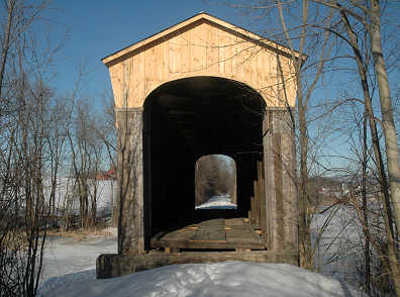
![Pulpmill Bridge [WGN 45-01-04]- Photo by Ed Barna, May 25, 2008](pulpmill_ebarna_080525.jpg)



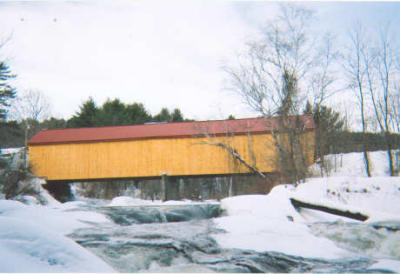
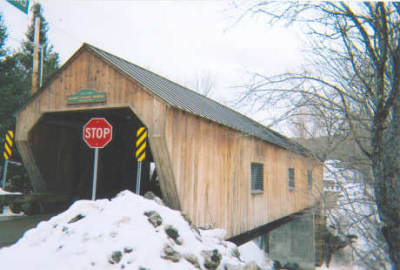
 Joe Nelson, P.O Box 267, Jericho, VT 05465-0267
This file posted 06/06/2008
Joe Nelson, P.O Box 267, Jericho, VT 05465-0267
This file posted 06/06/2008